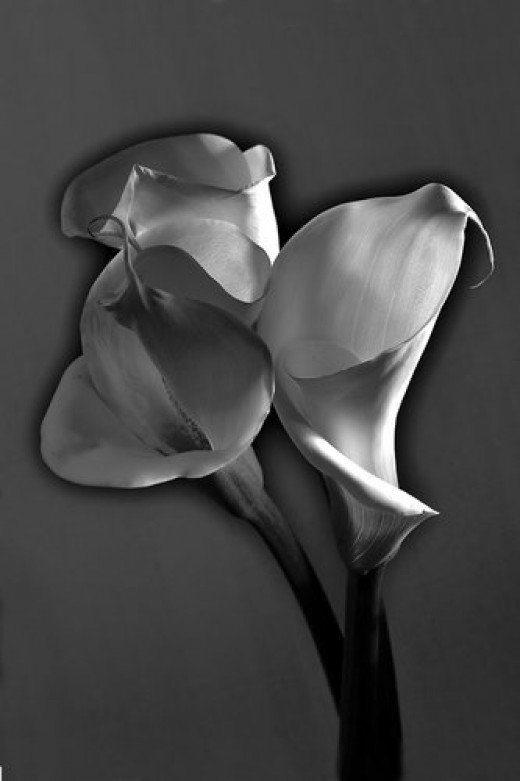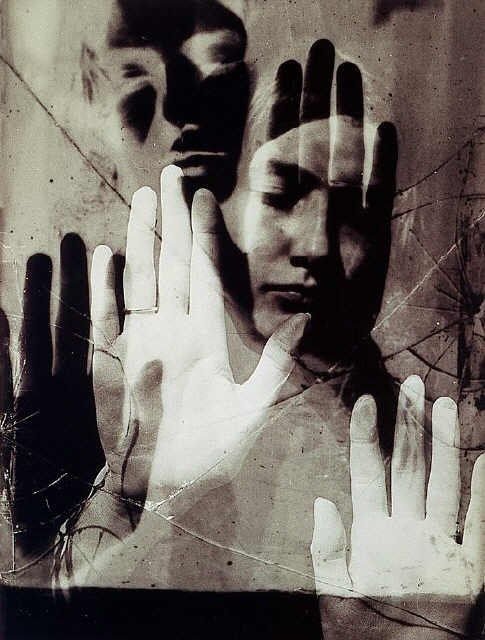Photograms (or "camera-less photographs") push photography to its logical extreme; they result from exposing photo-sensitive paper directly to light. Any objects blocking the light will leave a white silhouette, while the exposed areas of the paper become black, resulting in a negative image with little or no sense of depth. Widely practiced in botany in the 19th century, beginning in the 1920s this technique gained attention from artists and photographers looking to revolutionize ways of seeing. Invoking photography's literal meaning—"drawing with light"—Moholy-Nagy believed photograms exploited "light as a creative agent," embodying the medium's essence and allowing the photographer to create something never-before-seen, as opposed to merely reproducing the world. Dadaist Man Ray also staked a claim to the medium, naming it the "Rayograph" after himself.

Phogram by Man Ray
Darkroom
A room that's blacked out with enough space to lay three 10x8in printing trays in a row with a bucket of water nearby and an area where you can expose the paper to light.
Some photographers convert a spare room into a permanent darkroom others temporarily black out a bathroom or spare bedroom while they work.
Light source
Most photographers who make photograms will also be making prints using an enlarger. This provides an ideal concentrated light source for the exposure of the photogram, but is not essential because they can be made using the room light or a reading light.
Sheet of glass
This is used to hold flat subjects in close contact with the paper or to raise the subject from the paper to produce a softer edge.

Photogram by Adam Fuss
Safelight
Cost: About 15
Why you need it: A light source with a red or orange dome that does not fog paper so it allows you to see what you're doing in a room that would otherwise be totally dark.
Alternatives: Red bulb that replaces your household lamp. These can be used providing you do tests with your paper first to make sure it doesn't fog. Some lamps are only coated over the bulb and the base area lets white light through. You'll see the whites become grey, when processed if fogging is occurring.
Pack of 10x8in printing paper
Cost: Up to 10 for 25 sheets
Why you need it: Printing paper is coated with a light sensitive emulsion and is used to expose the items on to make the photogram.
Alternatives: None
Thermometer
Cost: About 7
Why you need it: The thermometer is used to ensure the chemicals are at the correct temperature. The temperature of the developer is the most important part but, unlike film, you can watch as the image appears and adjust the developing time accordingly. If you do develop your own films you should already have a thermometer.
Alternatives: The temperature of the developer is the most important but, unlike film, you can watch as the image appears and time the development accordingly. If you do develop your own films you will have a thermometer
Timer
Cost: About 10
Why you need it: This is used to time how long the paper is in the developer, stop bath and fixer, although accurate timing is less important than it is with film processing.
Alternatives: If your clock or watch has a seconds finger you can use that. Even the timer on your mobile phone could be used. Or you could count out elephants!

Photogram by Man Ray
Developer
Cost: About 3
Why you need it: A developer reacts with the exposed areas of silver in the paper's emulsion turning these parts black to form an image. Areas that receive more light become blacker when developed. Areas that receive no light stay clear. You have to use a developer to produce a result.
Alternatives: You could make up your own developer. See the article 'mixing your own chemicals'
Stop Bath
Cost: About 2
Why you need it: An acid solution that quickly counteracts the developer to prevent over development of the paper.
Alternatives: You can use water but it doesn't stop the developer as quick. As it's acetic acid some people use vinegar, but it's not recommended.
Fixer
Cost: About 3
Why you need it: This dissolves any unused silver halides that were not developed and stops the paper from being light sensitive.
Alternatives: You have to use a fixer otherwise the printed image will eventually turn black. You can make up your own fixer. See the article 'mixing your own chemicals'

Measuring cylinders
Cost: About 2 each
Why you need them: Most chemicals need diluting before use. The dilution rate can be difficult to measure without an accurate measuring cylinder, especially when the chemical to water ratio is large.
Alternatives: Any household measuring jug can be used providing it has the necessary measuring scales. You must not then reuse the measure for food because the chemicals used for processing are harmful.
Running water
Cost: Local water rates.
Why you need it: To ensure all traces of fixer are removed before the print is dried.
Alternatives: It's possible to wash prints in a bucket of water, but keep changing the water to ensure best results and give each print a final wash under a tap.
Three developing trays
Cost: Around 10 for the three.
Why you need them: To hold the developer, stop bath and fix for processing.
Alternatives: Some photographers use cat litter trays or garden seed trays (without holes). Make sure the trays are shallow and not much bigger than the maximum prints you intend to make to avoid using too much solutions to cover the print.

Photogram By Adam Fuss
Print drying rack
Cost: Around 20
Why you need one: It is an upright rack that has several slots for prints and allows air to travel over both surfaces to ensure rapid drying.
Alternatives: You can make your own (time consuming), hang them up using a washing line using clothes pegs (may leave mark on border) or lay them on a carpet (back won't dry as quick also dust is more likely to settle on surface).

Photogram by Man Ray
Some subjects to use
Nuts & bolts, keys, feathers, ferns, pieces of cut card shapes, stencils, scissors, tools, nails, safety pins, paper clips, springs, plastic and glass items, netting, developing reels, negatives, bottles, hands, feet, lightbulbs, shells, dried fruit slices...and, most of all...imagination.
Hope you like my post. Please feel free to comment / share.
Regards,
Denim
One more thing. Your photos are super cool. I will show this concept to my wife!
Hi. I am a volunteer bot for @resteembot that upvoted you.
Your post was chosen at random, as part of the advertisment campaign for @resteembot.
@resteembot is meant to help minnows get noticed by re-steeming their posts
To use the bot, one must follow it for at least 3 hours, and then make a transaction where the memo is the url of the post.
If you want to learn more - read the introduction post of @resteembot.
If you want help spread the word - read the advertisment program post.
Steem ON!
Can you please stop your spam marketing bot network? People think this has something to to with us.
Your spam bots:
https://steemit.com/@investigation/comments
https://steemit.com/@motomania/comments
https://steemit.com/@counterweight/comments
https://steemit.com/@extras/comments
We distance us from spam like this. @resteem.bot Team
Here's your new avatar, you imitator!

P.S.
I am sorry dear author of this post, that your post got dragged in this bullshit. I hope the fact that I upvoted you would be enough to not be angry at me for this argument.
The reason @resteem.bot says that I am spamming is because it is convenient for him to do so.
He is an imitator of @resteembot and is trying to take over it... or something like that...
If you still want to downvote me for spamming in your post - that is ok. It is your right.
Steem ON!
Thank you
Congratulations @denimchakma! You received a personal award!
You can view your badges on your Steem Board and compare to others on the Steem Ranking
Vote for @Steemitboard as a witness to get one more award and increased upvotes!